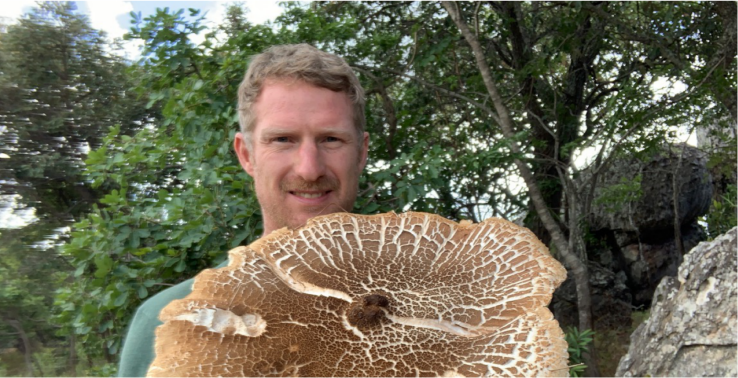
When it comes to farming, the earliest farmers on the earth are certainly not human beings. Termites and ants, as early as ten million years ago, could feed their own populations by cultivating fungi. Researchers have found fossils of fungus nurseries that termites cultivated 25 million years ago on the cliffs of Southwest Tanzania. The structure of fungus nurseries shows that termites can manage and fertilize fungi through complex planning as early as in ancient times.
Termites can cultivate fungi, but not all termites can. We have said before that there are a lot of microorganisms in termites that can help the lower termites to decompose lignin and obtain nutrients. However, in the process of system development, due to the absence of flagellate symbiosis in the gut of the higher termites, the higher termites lose the ability to decompose lignin and cellulose in the body. Evolution has encountered a bottleneck, which means death. Fortunately, some termites living in the tropical rainforest area of Central Africa have found a way to survive, that is, to cultivate fungi and let them decompose lignin and cellulose in vitro, so a new type of agriculture has emerged, and termites with new technology have begun to take the high road of cultivating bacteria.
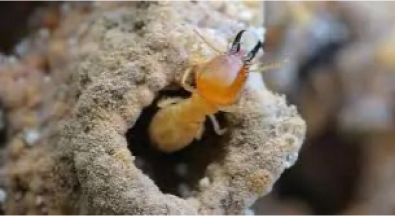

Macrotermitinae are widely distributed in the tropics of Asia and Africa. Large termites subfamily includes Macrotermes, Odontotermes, microtermes, uncistrotermes, etc. The termites of these genera can consume more than 90% of dry wood in tropical arid areas and mineralize more than 20% of primary products in rainy savanna areas. To a large extent, the consumption of lignocellulose by culturing termites is due to the special symbiotic relationship with basidiomycetes (Agaricales, Tricholomataceae, Termitomyces). In addition to their symbiosis with a large number of microorganisms in the gut like other termite populations, culturing termites do not directly eat the collected materials, but use these materials to cultivate fungi, establish a fungus garden, and cultivate symbiotic fungi. The only difference is that different species collect different lignocellulosic materials. For example, Macrotermes can collect debris from branches and leaves, while termites seem to collect wood mainly. Among these culturing termites, the unique fruiting body of cockfir fungus will grow from nest to surface with seasons.
The synergism between termites and conifer can utilize lignocellulose efficiently. Generally, the old workers eat and collect the dead branches and leaves outside the nest and bring them into the nest; in the nest, the small workers chew and absorb the collected dead branches and leaves, but the food is quickly discharged through the termite intestines without digestion, and the primary feces discharged form a sponge like fungus garden and provide for the growth of fungi; the fungi form mycelium and white asexual spores on the fungus garden, which are called fungus balls. Young workers usually nibble on the fungus balls, while old workers nibble on the old nursery to produce the final feces. However, the final feces are rarely found in the termite nest, which indicates that the litter is highly degraded and completely mineralized. It indicated that the symbiotic fungi had the ability to degrade lignin, which made the cellulose more easily degraded by the enzymes secreted by termites.

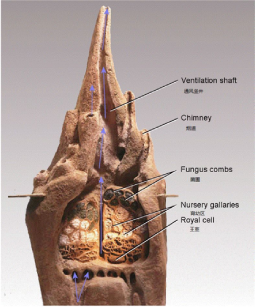
In the process of symbiosis between fungi and termites, there are some differences in the material composition of the nest due to its adjustable temperature and humidity. The upper plant residues are generally fresh, and the bottom plant residues are relatively thoroughly degraded. This is because termites constantly add fresh feces to the upper part of the nursery, while the bottom materials are constantly decomposed and utilized by symbionts It's the food of termites. In this way, through the synergism of symbiotic bacteria and termites, the substances in the nursery form a cycle and constantly replace.
The outer part of the nest often has a thick soil layer, and there will be vent holes in a certain part, which is conducive to maintaining the temperature of the nest, reducing water loss and maintaining CO2 concentration, so as to provide suitable living conditions for the nest umbrella and termites. The temperature in the nest is stable throughout the year, generally at 25-28 degrees. In terms of humidity, the relative humidity of the air in the nursery is stable all the year round, generally higher than the surrounding soil, up to 90%. The nursery mainly composed of termite primary feces is generally acidic, and its pH value is lower than the surrounding soil, generally 4.50-6.85. Another characteristic of the nursery is that the CO2 concentration is very high, almost 100 times of the atmospheric CO2 concentration (generally 0.03%) (about 2.7%) The high CO2 environment can inhibit the spore germination and mycelium growth of most fungi, thus ensuring the dominant position of symbiotic bacteria in the nursery.
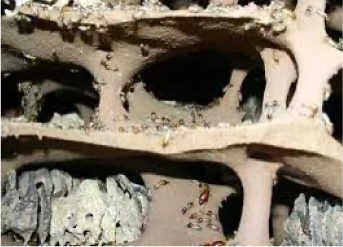
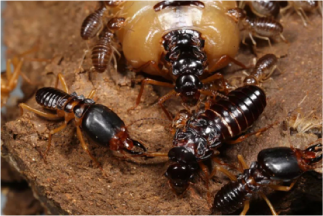
In the process of symbiosis between fungi and termites, there are some differences in the material composition of the nest due to its adjustable temperature and humidity. The upper plant residues are generally fresh, and the bottom plant residues are relatively thoroughly degraded. This is because termites constantly add fresh feces to the upper part of the nursery, while the bottom materials are constantly decomposed and utilized by symbionts It's the food of termites. In this way, through the synergism of symbiotic bacteria and termites, the substances in the nursery form a cycle and constantly replace.。
The outer part of the nest often has a thick soil layer, and there will be vent holes in a certain part, which is conducive to maintaining the temperature of the nest, reducing water loss and maintaining CO2 concentration, so as to provide suitable living conditions for the nest umbrella and termites. The temperature in the nest is stable throughout the year, generally at 25-28 degrees. In terms of humidity, the relative humidity of the air in the nursery is stable all the year round, generally higher than the surrounding soil, up to 90%. The nursery mainly composed of termite primary feces is generally acidic, and its pH value is lower than the surrounding soil, generally 4.50-6.85. Another characteristic of the nursery is that the CO2 concentration is very high, almost 100 times of the atmospheric CO2 concentration (generally 0.03%) (about 2.7%) The high CO2 environment can inhibit the spore germination and mycelium growth of most fungi, thus ensuring the dominant position of symbiotic bacteria in the nursery.
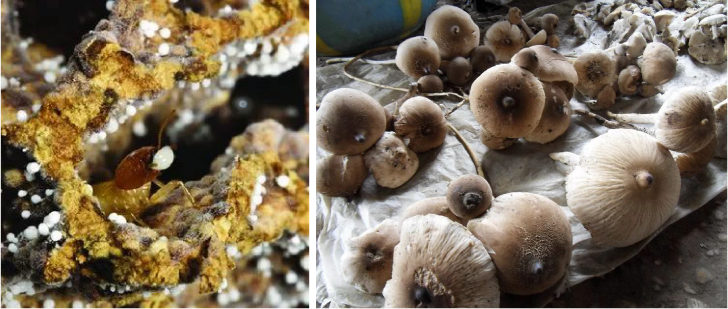
In 1799, Konig, a German naturalist, discovered the honeycomb structure in the termite nest of East India. Since then, scientists have shown great interest in nesting termites. In 1906, Petch studied the relationship between Micrococcus in the nest and the fungal fruiting bodies formed outside the nest, and proposed that these large fruiting bodies were cultured by termites in the nest. In 1941, Heim et al. Created a new genus for these fungi, Termitomyces.
The advanced culturing termites and symbiotic bacteria have evolved in millions of years. In proper seasons, termites will transport the fragments of the fungus garden full of hyphae to the outside of the ant nest. When there is enough rain, they will grow fruiting bodies. Termites will collect the arms ejected to the ground and transport them to the ant nest for re inoculation. This behavior of termites helps the spread and spread of symbiotic bacteria, and even provides opportunities for gene exchange of fungi. In addition, termites shred, swallow and digest fresh plant tissues outside the nest, and then accumulate the feces containing a large number of plant residues in the nest to form a fungus garden. As the substrate for fungus growth, symbiotic fungi can grow vigorously in the nest, and largely rely on termites to continuously secrete chemicals that inhibit other fungi from the mouth, so as to remove the feces on the fungus garden Heterophytes ensure that Termitomyces is in a favorable position in the competition. For termites, the existence of a fungus nursery is a necessary condition for their long-term survival. By secreting highly active hydrolase, the fungi in the nursery can help termites to degrade some plant food (such as wood, thousand grass, dead branches and leaves, etc.) that they depend on for survival, generate the nutrition and energy necessary for termites' growth and development, such as sugar available to termites, and provide vitamins for termites. The metabolism of fungi and other microorganisms in the nursery also plays an important role in maintaining the stable and suitable temperature, humidity and ventilation conditions for termites.
The termites have cultivated cockfir fungus and a series of famous Chinese dishes. There are the most kinds of termites in Southwest Guizhou, China, and there are many kinds of cockfir fungus naturally. Therefore, Yunnan's cockfir fungus is also the most famous. However, phd.z has never eaten it, and I don't know if it really tastes good. But it's also because of the high termites who cultivate the fungus that we can have such a good food, so we should not look at it while enjoying the delicious food Termites fight for their enemies. After all, they eat people short
